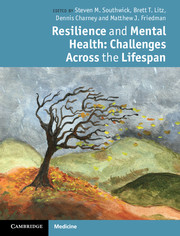Book contents
- Frontmatter
- Contents
- Contributors
- Preface
- Section 1 Pathways to resilience
- Neurobiology of resilience
- 2 Resilience in the face of stress: emotion regulation as a protective factor
- 3 Cognitive factors and resilience: how self-efficacy contributes to coping with adversities
- 4 Personality factors in resilience to traumatic stress
- 5 Social ties and resilience in chronic disease
- 6 Religious and spiritual factors in resilience
- Section 2 Resilience across the lifespan
- Section 3 Resilience in families, communities, and societies
- Section 4 Specific challenges
- Section 5 Training for resilience
- Index
- References
4 - Personality factors in resilience to traumatic stress
from Section 1 - Pathways to resilience
Published online by Cambridge University Press: 07 September 2011
- Frontmatter
- Contents
- Contributors
- Preface
- Section 1 Pathways to resilience
- Neurobiology of resilience
- 2 Resilience in the face of stress: emotion regulation as a protective factor
- 3 Cognitive factors and resilience: how self-efficacy contributes to coping with adversities
- 4 Personality factors in resilience to traumatic stress
- 5 Social ties and resilience in chronic disease
- 6 Religious and spiritual factors in resilience
- Section 2 Resilience across the lifespan
- Section 3 Resilience in families, communities, and societies
- Section 4 Specific challenges
- Section 5 Training for resilience
- Index
- References
Summary
Introduction
The study of individual differences in resilience to traumatic stress has received unprecedented attention in recent years from investigators in the field of post-traumatic stress disorder (PTSD) but there remains a lack of consensus regarding the definition, measurement, and conceptualization of the construct. Trait personality psychologists have grappled with similar issues since the seminal work of Jack Block (1961) on the construct of ego resilience over 50 years ago. In the process, they have developed comprehensive models of personality and psychometrically sophisticated tools for the measurement of its traits that can potentially inform and advance the study of resilience. The primary purpose of this chapter is to review the literature on personality factors involved in resilience to traumatic stress and to outline a model for conceptualizing this interface.
Contemporary models of personality aim to identify the structure and basis for behavioral traits – defined as individual differences in patterns of thoughts, feelings, and actions that are consistent across developmental periods and environmental contexts. Personality models differ considerably with regard to the factor structure, number, and definition of specific traits. Because of this, research on personality traits that confer risk or resilience to the development of post-traumatic psychopathology has yielded a complicated collection of studies examining disparate constructs and measures. To provide coherence and organization to this literature, this chapter will focus on three broadband personality dimensions described by Tellegen (1985, 2000) that are also represented with subtle definitional variations in most other contemporary trait models of personality. For this reason, they are known as the “big three” personality factors: positive emotionality/extraversion (PEM), negative emotionality/neuroticism (NEM), and constraint/impulsivity (CON).
- Type
- Chapter
- Information
- Resilience and Mental HealthChallenges Across the Lifespan, pp. 56 - 75Publisher: Cambridge University PressPrint publication year: 2011
References
- 7
- Cited by



